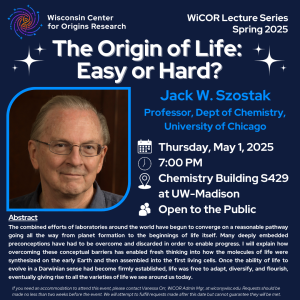Miss this event? Watch the recording on YouTube: https://youtu.be/C3lHlf4QWjc
This event is open to the public – please share with friends and family!
Title: The Origin of Life: Easy or Hard?
Abstract: The combined efforts of laboratories around the world have begun to converge on a reasonable pathway going all the way from planet formation to the beginnings of life itself. Many deeply embedded preconceptions have had to be overcome and discarded in order to enable progress. I will explain how overcoming these conceptual barriers has enabled fresh thinking into how the molecules of life were synthesized on the early Earth and then assembled into the first living cells. Once the ability of life to evolve in a Darwinian sense had become firmly established, life was free to adapt, diversify, and flourish, eventually giving rise to all the varieties of life we see around us today.

Speaker Bio:
Dr. Szostak received his B.Sc. from McGill University in Montreal in 1972, and his Ph.D. from Cornell University, Ithaca, NY, in 1977. Dr. Szostak is a University Professor and Professor of Chemistry at the University of Chicago, and an Investigator of the Howard Hughes Medical Institute. Dr. Szostak is a member of the National Academy of Sciences and the American Philosophical Society, and a Fellow of the Royal Society, the American Academy of Arts and Sciences, and the American Association for the Advancement of Science.
During the 1980s Dr. Szostak carried out research on the genetics and biochemistry of DNA recombination, which led to the double-strand-break repair model for meiotic recombination. At the same time Dr. Szostak made fundamental contributions to our understanding of telomere structure and function, and the role of telomere maintenance in preventing cellular senescence. For this work Dr. Szostak shared, with Drs. Elizabeth Blackburn and Carol Greider, the 2006 Albert Lasker Basic Medical Research Award and the 2009 Nobel Prize in Physiology or Medicine.
In the 1990s Dr. Szostak developed in vitro selection as a tool for the isolation of functional RNA, DNA and protein molecules from large pools of random sequences. His laboratory used in vitro selection and directed evolution to isolate and characterize numerous nucleic acid sequences with specific ligand binding and catalytic properties. From 2000 until the present Dr. Szostak’s research interests have focused on the laboratory synthesis of self-replicating systems and the origin of life.
Directions:
Chemistry S429 is accessible from the North Tower entrances at the corner of University Ave and N. Mills Street. Take the elevator or stairs down to the Floor S, the sub-basement level, and find S429, the John Morgridge Lecture Hall.
If you need an accommodation to attend this event, please contact Vanessa Orr, WiCOR Admin Mgr, at wicor@wisc.edu. Requests should be made no less than two weeks before the event. We will attempt to fulfill requests made after this date but cannot guarantee they will be met.
